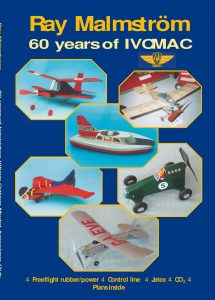Friendship, Flying and Fun
In Cambridgeshire secondary schools are called, “Village Colleges” and Impington VC was one of the first. The buildings of 1938/9 by Walter Gropius and Maxwell Fry are Grade I listed. The school opened in 1939, two weeks after the outbreak of World War II. As a village college, it was originally intended to encompass all aspects of learning in the village, and included prominent space for adult education.
Ray Malmström was appointed art teacher shortly after the war and founded the “Model Air Squadron” in May 1946. This later became known as Impington Village College Model Aeroplane Club. Many of his designs were first built by his pupils, many of whom remained members of the club all their lives. The small field suited his rubber free flight designs, or is that the other way around. Indoor flying took place in the hall and his art room, even i/c ’round the pole’. Ray created the clubs motto of “Friendship, Flying and Fun” all those years ago and it still forms the club ethos to this day.
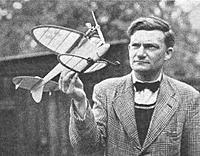
Ray holding Mimi, a 1953 design for the Aero Modeller
More about our founder Ray Malmstrom
The article below is by Alex Imrie and appeared in the May issue of the AeroModeller in 1986
Ray Malmströms contributions to the hobby are well known, and vintage enthusiasts who thumb through old magazines cannot fail to have noticed his cartoon work both as article illustrations and as caricatures in series like “Caricaplanes” and “Aerobods of Note”, not to mention the countless model designs (there were over 500 of them during the last 50 years), that appeared in many publications world-wide including AeroModeller, Model Aircraft and Meccano Magazine.
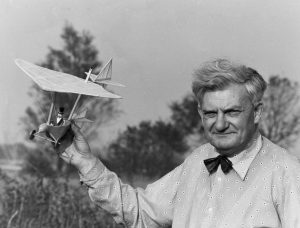
His model designs were often caricatures in the true dictionary meaning of the word and had “characteristic traits exaggerated in a ludicrous way”. He did this to such good effect that most of us have built one or more of his models sometime or other. One thing all his designs had in common was that they all flew. They were simple yet “different” and were aimed mainly at the younger modellers and most of them could be built from the scraps of balsa left over from building “conventional” models, thus cost was never a factor that might have suppressed the desire to construct a Malmström design.
Ray’s earliest contribution to AeroModeller was the ‘Pee-Wee’, a baby indoor duration model of 8 inches wingspan that appeared in the November 1940 issue. It was followed by ‘Horus’, ‘Tom-Tit Triplane’ and the ‘Avenger’, the latter being the simple indoor forerunner of the ‘Kestrel’ and ‘Merlin’ twins. The ‘Avenger’ had mere sticks for motors, a profile fuselage and a high mounted “T” tail, altogether like a Westland Whirlwind; it was produced at the time when there was great interest in the indoor evening flying that included much of the RTP (Round the Pole) variety. His attractive ‘Kestrel’ appeared in August 1944 Aero Modeller; being presented in half-size meant that for some time it was a chore to enlarge and one wonders how many readers built a model of this nice looking twin-engined (and twin-fuselaged) fighter of 21 inches wingspan.
Its high speed flights of 20 to 30 seconds duration were “due reward for those who built it”. Another smart design in similar vein appeared in the February 1945 AeroModeller, the ‘Merlin Mk 1’ twin-motor fighter-bomber, again regrettably presented in half-size. Ray’s description tells us the reasoning behind this type of model. “. . . an attempt . . . to create a model that follows, without being a copy, the general layout of a type of aircraft that has won battle honours in every theatre of war. . . In conclusion, the designer . . . believes that future development of, and research
into, the hobby of aeromodelling must, and eventually will, be directed to the production of models that are in real truth MODEL AIRCRAFT… ” This is the semi-scale approach that was common both before and during the war, but which gradually lost support due to the rapidity and ease with which flying scale models of real aircraft could be produced especially after the coming of the miniature compression-ignition or diesel engine.
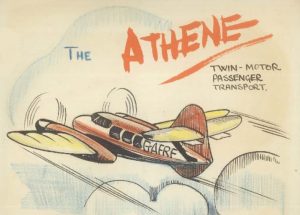
In October 1946, a full-size plan appeared in AeroModeller for his twin-engined civil machine called ‘Athene’ whose shapely fuselage was built on the keel-system of construction; if lightly built and fitted with efficient propellers, the power contained in the 8 inch long engine nacelles should, especially with today’s know-how, produce a high-performing feeder-airliner. Ray was one of the old school who continued to make semi-scale models with “exaggerated characteristic traits” and never stopped using rubber power because of its obvious simplistic appeal to beginners; however, he quickly saw the advent of the small diesel and Jetex units as providing the ideal means of powering his creations and designed accordingly.
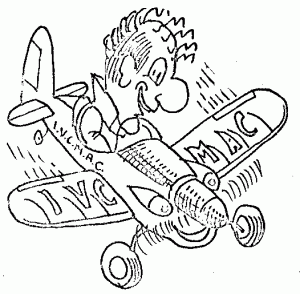
Another practice that he developed regardless of the page size at his disposal was to show important parts full-size, and some of his layouts in books and magazines are masterpieces of this art. Possibly his most famous creation was Fliar Phil – the antics that this cartoon character got up to were legion, yet all the situations could be identified with the hobby. AeroModeller’s popular “Photonews” of the wartime years concerned full-size aircraft, but with the easing of the war situation it slowly gave way to “Model News”, a keenly read photographic section entirely devoted to models.
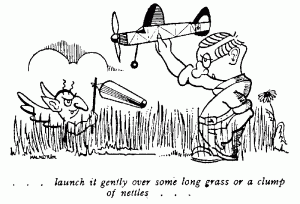
When we look at the 1945 issues of the magazine we see that this is merely a page of photographs with short captions, but, from January 1946, this feature boasts a “Malmström” cartoon title, a different one being drawn every month for this purpose right into the 1950’s – well past the end of the vintage period. More detailed captions now appeared as “Selected Items by Fliar Phil” and the amusing commentary by Ray on the photographs submitted by readers was to long remain a popular AeroModeller item. As present day readers know, a “Photo Prize” version of “Model News” has appeared since March 1983 run by the same irrepressible Fliar Phil.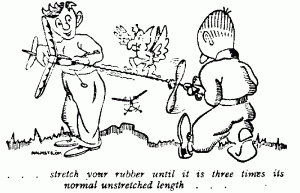
Apart from the activities mentioned, Ray found time to produce a number of books for which he wrote, drew and photographed the entire contents. These included the four Eagle Books of Model Aircraft, Model Boats, Model Cars and Model Space-craft, also two books published by Arco, one on Model Space-craft and the other on Aeromodelling. All these are sought after by collectors nowadays. His “space-age” contributions led to a series of models printed in colour on the back of an international breakfast cereal company’s products, and Ray admits to nipping secretly into Tesco’s to admire his handiwork on the shelves!
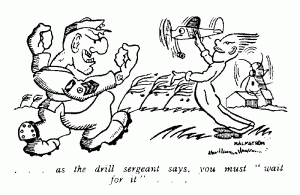
Grandfather Malmström was a Swedish boot maker who took an English wife and settled in this country setting up a business in London; a son, Ray’s father, was also business-minded and kept a toyshop in the Southsea area of Portsmouth and in the late 192os stocked various flying toys including some of the Appleby card model aeroplane kits. It was the sight of these excitingly boxed models that fired Ray’s imagination and, as we shall see, started him off on aeromodelling. But there was also school, and. after attending St John’s Secondary School, the young Malmström studied art at the Southsea College of Art, and apart from continuous model building, naturally developed an interest in full-size aviation.

A fascinating aspect of his early modelling, which showed a business-like approach, concerned his offer to the pilots of the air service operators running to the Isle of Wight and Jersey to make scale models of their machines. He sold models of the DH 84 Dragon to pilots of Jersey Airlines who operated that type from Southampton and Portsmouth, and to the pilots of Southampton, Southsea and Isle of Wight Aviation Ltd operating a de luxe Westland Wessex, Monospar and Fox Moth to the Isle of Wight, miniatures of their aircraft. With this money he was able to take flying lessons with the Portsmouth Aero Club on Gipsy Moths, and also, when space allowed, he accompanied F/O Brown on flights in the Wessex.
With the approach of war, as his art studies allowed, he undertook work of national importance when he joined the Auxiliary Fire Service and it was during this period that he made the ‘Pee-Wee’ indoor model which was flown in the confines of the Fire Station. Enterprising Ray sent the design to AeroModeller and it appeared the following year, his first published design. Finally he took his art teacher’s diploma at Brighton in 1939 and this led to an appointment as junior art teacher at Kendal Grammar School.
The outbreak of war made this employment of short duration, but Ray found time to form and run an active model aeroplane club at the school. However, soon in 1940 he entered the RAF and AC 2 Malmström was trained as an armourer serving with No 249 (Gold Coast), 71 (Eagle) and 56 Squadrons. One of many interesting stories that he tells of his RAF service took place at North Weald when, as a corporal, he was working on a Hurricane IIC armed with four 20mm Hispano cannon. The CO brought an Air Ministry photographer out to the aircraft and allowed him to sit in the cockpit while Ray lingered nearby. Suddenly the guns went off with a shattering roar as the photographer caught up the firing button with his camera gear. Ray was stone deaf for three days! Eventually the RAF found out that he was a trained teacher and Ray was sent to a training unit and eventually became a sergeant armament instructor but was demobbed shortly afterwards.
He returned to teaching in 1946 when he took up an art teacher post at Impington Village College which is close to Cambridge; he was to remain there for 40 years and finished up as head of art studies. Needless to say, he lost little time in forming a model aeroplane club at the school – this rejoiced under the name of Model Air Squadron with himself as CO. Hundreds of youngsters passed through that club and Ray regularly gets letters from aeromodellers all over the world who were his pupils. Some of the founder members are still in the club which is a very successful one and attracts enthusiasts from all over Cambridgeshire who regularly travel up to 50 miles for an evening session.
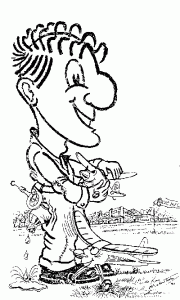
Members include Mick Reeves, inter-nationally famous R/C flier, Henry J Nicholls and the SMAE Treasurer Robin Gowler. Ray always attends and brings a clutch of indoor rubber models to fly in the school hall in winter and on the playing fields during summer evening sessions. He still teaches part-time at the College and is still building models carrying on the tradition he started so long ago.
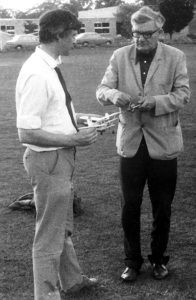
Although the foregoing is an attempt to tell something of Ray’s background, just how the youngster from Southsea with the Swedish name started into the hobby is best related by Fliar Phil himself. Here he indulges in a bit of nostalgia:-
“I was about 12 years old when my father, dear soul, succumbed to my repeated onslaught and bought me my first model aeroplane kit. And what a kit! An all- cardboard affair, designed, I feel, by someone who certainly had little aeronautical knowledge, but made up for it with an immense and touching faith in the gods! It was supposed to build up into a model of the fascinating little Wee Bee I Beardmore monoplane! God – that cardboard resembled good quality sheet iron! Only a particularly evil smelling virulent variety of fish glue could hold it together.
My father, sweat wreathing his bald but noble napper, did indeed manage to get the fearsome aerofoil section (?) wing to stick, but unfortunately only to the backside of his trousers – this act of unquestioned dedication was achieved by accidentally sitting on it. The resulting model was, in the light of subsequent efforts, a catastrophe that put WWI, the Wall Street crash and the General Strike rather in the shade. But bless its reinforced cardboard heart it set me out on our great hobby of aeromodelling.
Early days included flying the inevitable Warneford spruce and silk jobs, and then on to that great design by dear much respected ‘RIP’ – the Cruiser Pup – my model of which departed this life a couple of thousand feet up over Portsmouth Harbour, 12 minutes OOS. Long flights with a Burd Thermalider (cost of kit about three bob (15p) – with a machine or saw-cut balsa propeller), an introduction to the joys of scale with a Captain Pages Racer – a Comet kit from Sweetens in Blackpool, and a monstrous 5 feet span rubber-powered Rearwin Speedster – another dreamboat from Burd – and it flew!
Recall the days when it was considered a sign of moral turpitude (not to say indecency) to turn up on one’s local flying patch with a Wakefield, that sported less than a couple of dozen sylph-like stringers encasing its streamlined figure. Flew Copland’s ‘GB3’ and Stott’s ‘Flying Minutes’ with success. Built Cahill’s ‘Clodhopper’ (ugly brute!) – the model, not the bloke – but it tried conclusions with some decidedly unfriendly telegraph wires which did absolutely nothing for its subsequent trim! Great streamliner days those – until Dick Korda wrote “finis” to the streamline syndrome with his slab-sided masterpiece.
About this time helped to run the Portsmouth MAC and founded the Kendal Grammar School MAC. Lots of keen aerobods – but then yours truly (and some of his senior pupils) got mixed up with the RAF and a five year stint assisting a few million others to put Hitler’s mob where they couldn’t rock the civilised boat again.
Back in the teaching biz once more, founded the Impington Village College MAC in 1946 – and, like the famous brand of whisky, (thank you, I don’t mind if I do!) IVCMAC is still going very strong. Got aeromodelling included in the official curriculum and discovered what a help it was to both the bright lads, but especially to those whom educationists describe rather delicately, as “the less able”. There was nothing “less able” about ’em when they got the feel of balsa in their souls and the lovely reek of dope up their “hooters”! Even the headmaster smiled as their gliders glided and control-liners circulated, and the free-flight jobs washed out most of the glass in the greenhouse of the gardening section!

Reprinted here with the kind permission of the editor.
Video of Ray Malmstrom flying some of his models
Click here to view the video
Book about Ray Malmstrom and the history of IVCMAC
Credit for preparing this book goes to:
Chris Strachan
Clive King
John Valiant
Chris Hinson
Terry King
Peter Hoskison
Ray’s wife Sheila, daughter Elizabeth and grandson Peter
Ron Moulton
Tony Dowdeswell
for further details, see below
Inside front cover, Inside Back cover and Back cover
p1 to 6 The man of a million models
p7 to 11 In the beginning
p12 to 13 I say, I say, Isay
p14 to 18 The Pee Wee, The Avenger, Aeronca 300
p19 to 27 MIMI, Martian, SAAB J 29, Bambinetta
p28 to 37 Push-Up, model’n tips, Invicta, Herald
p38 to 42 Cosmic Wind, Cosmos, Invicta
p43 to 52 Mini Master, Stardust, Jet Stream, The AVRO F,Eastbourne Monoplane, Starduster
p53 to 56 SAAB A37 Viggen, Bambina
p57 to 59 AVRO 504K
p60 to 64 Miss Starstreak, Sweetheap, Primary Glider
p65 to 72 Spitfire VB, OLE Tiger, Canard-Air
p73 to 80 Tailup, Arrowair, Flier Phil’s Flier
p81 to 89 Avions Hanriot, Viking, The Wren, The Starfli, Space-Ace
p90 to 94 Ascenda and tribute by Ron Moulton
Malmstrom Remembered
An account of a visit paid by Doug Gillies and Bill Hannan in 1975. Reproduced from Bill Hannan: Model builders & their models (2002) with kind permission of the author
Click here for the article
Catalogue of Ray Malmstrom Plans
There is a catalogue of Ray’s plans which was created by Dennis Sharman and is maintained by John Valiant.
Click here for the catalogue

